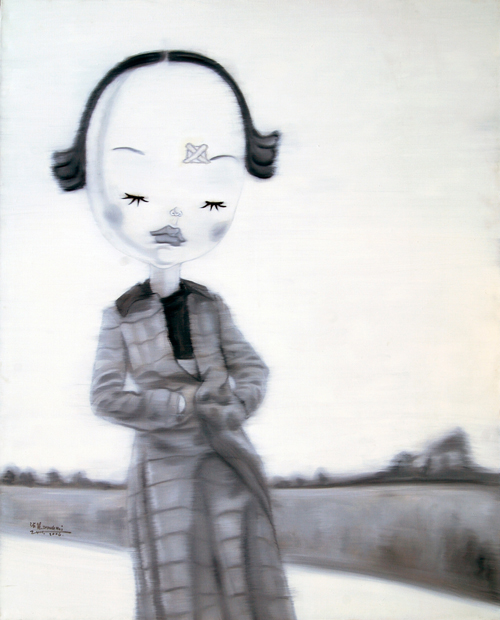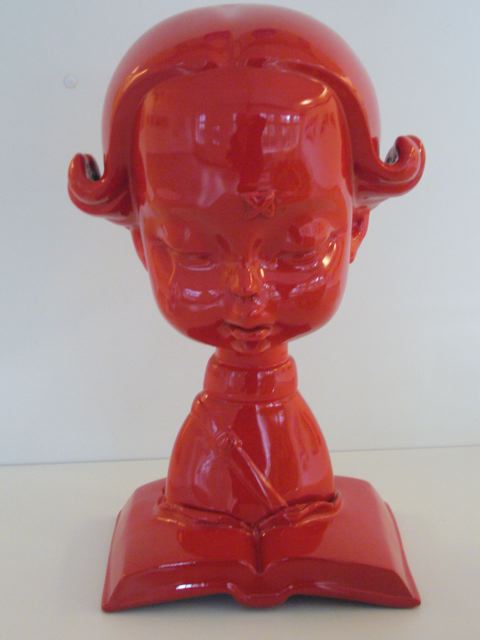Works
Vita
Cartoon and comics are predominant trends among young artists born in the “After Seventies”. This also applies to Zhang Hui, who has a natural feeling and awareness of your environment. She recently created a series of canvases and sculptures called ‘Beijing Girls’, which revolves around the interests and values of young people. Their general appearance and figures have the visual features of cartoons and caricatures. Zhang Hui’s work, however, bears highly individualized features that set her apart from the works of other young artists with cartoon tendencies. This leaves a strong impression on the audience.
The human figures in Zhang Hui’s Beijing Girls have short and curly hair of strong, nostalgic coloration – they look like figures on calendars from the time of the People’s Republic of China. The combination of these haircuts with dance skirts, business suits, school uniforms and cat suits from completely different periods of time, with the same person, conveys a sense of recognition and confuses at the same moment. High-drawn eyebrows, bedroom views and four eyelashes, a drawing style used exclusively by this artist, give the figures their unique expression. If we look at the lower half of the face, the high upper lip immediately captivates us. The wearer of all these facial expressions is a huge head that is not in balance with the body. Perhaps we can see many such large-headed figures in many young artists. And we can say that such figures refer to caricatures of Koreans and Japanese. This is, of course, the result of the progressive assimilation of Asian cultures. But the haircut of the People’s Republic of China is a typical feature of Zhang Hui.
Another difference from other artists is that Zhang Hui’s figures, whether they are clothing, backdrop or behavior, are clearly recognizable as objective constructs of the artist. The characteristics are deliberately assembled or feigned from various temporal, spatial or cultural offsets. The selection and abstraction of cultural elements is obvious. In other works by Zhang Hui, one can contemplate the rebirth of an artistic image in front of the pop-cultural background of contemporary society. This kind of image is artistically created, yet the viewer can easily find objects of daily life – a bag, a small firecracker and a connected wound. In comparison, the people of other artists appear far too close to reality or form too much from the image itself; they do not experience independent and intact individual figure-making. In addition, Zhang Hui often uses a cool, reduced black, white and brown for her canvas work. This is not often seen in young artists of this era. In general, cartoon artists always prefer colors, especially natural colors. In Zhang Hui’s works, however, we always see a conscious resistance to color. In this way, her paintings give the viewer an impression of reason and distance.
It is not easy to say that only cold colours convey criticism and reason, because we see in many artists that bright colors can have exactly the same effect. However, when we return to Zhang Hui’s work, we can see the true reason for their use of cold colors, besides the backdrops and behavior, besides the connected wound, the thin cigarette, the large pupils, the knotted, sleepy looks and the doll-like drawing style. . she wants to express the lonely and vulnerable among young girls who look like stupid boys but are actually very smart. As Zhang Banqiao once put it: “It’s difficult to be confused.” How can these big city dolls, with a view to a changing social life, keep their heavy heads on their shoulders? How can they carry the weight of life on their little feet?
The refusal to grow up refers to the defense of a successful temptation and interference in the social life of most people. This is a lesson for all young people and does not lead directly to cultural, artistic matters. From the point of view of art, in order to create a matter of art, the artist must find his own unique artistic solution. Only when he has found access can he influence the problem. But it is the audience that needs to understand the answer. Zhang Hui’s current efforts allow us to see valuable art in the real contradictions that young people face today.
Contact


